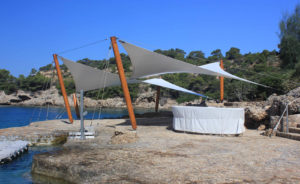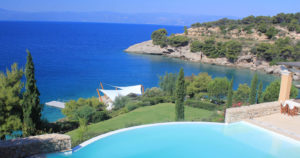 Fabric and wood structure protects guests and remains loyal to marine history of the Mediterranean.
Fabric and wood structure protects guests and remains loyal to marine history of the Mediterranean.
With centuries of boat building in Spetses’ past, it makes sense that a new tensile shade structure for an exclusive seaside resort on this Greek island should look like it came from a classic Mediterranean boatyard.
The owner of a Spetses villa approached Tensis, the Athens-based tension structure firm, to design, engineer and construct a tensile canopy for an exclusive seaside courtyard. The client brief called for a shade structure with a striking architectural quality that could protect a private area where guests dine, sunbathe, and enjoy stunning ocean views.
Structural engineer and Tensis owner Argiris Chatzidis has become adept at interpreting the marine history of the Mediterranean in fabric and wooden tensile structures of elegant detail. “The new lightweight structure had to be robust in order to withstand strong seasonal winds,” Chatzidis says, “as well as direct ocean wave impact forces throughout the year.”
Chatzidis shaped the structure to suggest sails and boat rigging using tapered wood masts and stainless steel fittings, all the rigging and components polished to form a weather-resistant finish.
“The chosen option involved a combination of natural ingredients, low weathering and ease of maintenance for an environmentally friendly solution,” Chatzidis says. This included natural oil-based yacht varnish made from renewable resources like linseed oil, pure Tung oil resin and vegetable thinners and driers.
 The area covered by fabric is about 120 sq. m., kept column free by placing the masts at the perimeter of the site. As the seaside terrace was not accessible by vehicles from land or sea, the fabric structure had to be erected without any cranes. Therefore, much of the assembly took place on site. “Timber masts had to be light, shop drawing details prepared accordingly and particular focus paid to ensure dimensional accuracy when fabricating the glulam masts and steel flitch plates,” Chatzidis says.
The area covered by fabric is about 120 sq. m., kept column free by placing the masts at the perimeter of the site. As the seaside terrace was not accessible by vehicles from land or sea, the fabric structure had to be erected without any cranes. Therefore, much of the assembly took place on site. “Timber masts had to be light, shop drawing details prepared accordingly and particular focus paid to ensure dimensional accuracy when fabricating the glulam masts and steel flitch plates,” Chatzidis says.
During design phase, Tensis considered the unique weather conditions of the coastal location, accounting for the high-speed winds and typical waves of brutal force that impact the structure throughout the year, making for complex engineering analysis. The masts are tied back with stainless steel wire ropes to anchor points in the shore’s rocks. All metalwork was fabricated with pre-planned node points for ease of site assembly and corrosion protected by using 316L stainless steel with a mirror finish.
As the connections throughout the structure needed to be reliable to hold up against the harsh environment, it was essential that each connection point be secure. Anchors are fastened to the rock with Hilti Hit-Hy 200-A injectable mortar, timber masts are glulam G24H, and rigging cables are 7×19 A4-AISI 316 stainless steel.
All wood members are elliptical in shape in cross section, and have the same section sizes at the middle (280mm) and two ends (230mm), but each varies in length, ranging from 2.2 m. to 4.7 m. “This shape enhances appearance and allows for improved structural performance,” Chatzidis says, “to withstand flexural buckling while keeping the total weight low.”
 Both ends of each mast are cut flat and slotted to accept a T-shaped flitch plate bolted and glued with a construction-grade adhesive specially developed by the yachting industry. For the rigging, Tensis used traditional and classic stainless steel wire rope slings with steel thimble eyes in the loop ends (used only in the replaceable tieback cables clinched to the rock anchors) and swaged wire rope fittings (for those attaching to the main tensioning membrane clamp plate bolts.)
Both ends of each mast are cut flat and slotted to accept a T-shaped flitch plate bolted and glued with a construction-grade adhesive specially developed by the yachting industry. For the rigging, Tensis used traditional and classic stainless steel wire rope slings with steel thimble eyes in the loop ends (used only in the replaceable tieback cables clinched to the rock anchors) and swaged wire rope fittings (for those attaching to the main tensioning membrane clamp plate bolts.)
Fabric for the canopy is Serge Ferrari Précontraint® 1002 Fluotop® T2 (PVC-PVDF lacquered polyester) that provides translucency and soft, even light to the space beneath the cover. The 1002 T2 fabric is capable of surviving the hot Mediterranean weather and high winds (up to 33 m/s [74 mph]).
 The light conditions at Spetses are often extremely bright, with both sky and ocean a vivid blue. It is the quality of the light that lends a sharp precision to the shadows and details of the structure and brings guests back again.
The light conditions at Spetses are often extremely bright, with both sky and ocean a vivid blue. It is the quality of the light that lends a sharp precision to the shadows and details of the structure and brings guests back again.
The fabric canopy at Spetses, reminiscent of the white sails of sailboats on the sea, undoubtedly is one of the more striking features that holds sway over this exotic landscape.
Bruce Wright, AIA, a licensed architect, is a media consultant to architects, engineers and designers, and writes frequently about fabric-based design.
 TEXTILES.ORG
TEXTILES.ORG


